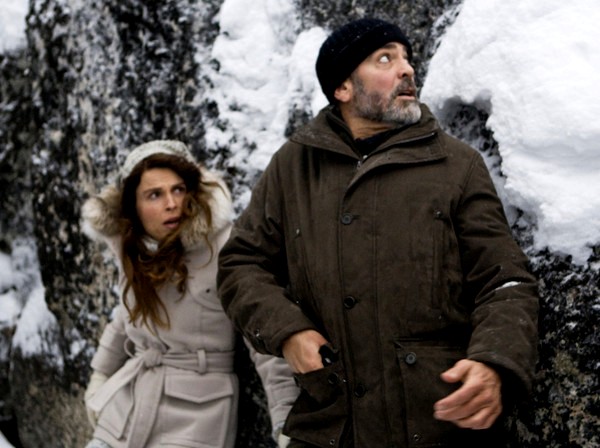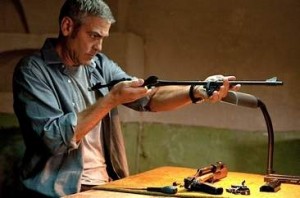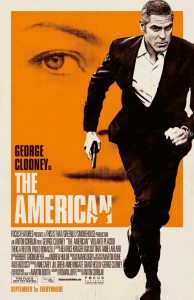
In response to the new film The American, some audiences are going to find its meditative distance and ambiguity to be mesmerizing and some will find that because it slows its pace down to the rituals of real life, that it is boring. George Clooney, in full undeterred grimace, is a hitman trying to get away and stay low. The methodical pace lets you concentrate on the realities of a hitman’s life rituals, and if you accept, the frequent pauses benefit the style and atmosphere of the story.
The title of the original novel was better apt. Martin Booth’s 1990 novel “A Very Private Gentleman” was the name, and it probably contained terse conversations and internalized anguish as well. For the book to be adapted, it must have needed star power to attain commercial purposes. Clooney is a star that happens to be an actor first, and here he makes silence magnetic with his protagonist Jack, who sometimes goes by Edward. Father Benedetto (Paolo Bonacelli) is his only regular speaking buddy in the first half of the film. If you are enrapt by the film’s visual storytelling and by the mystery of Jack’s enigmatic background, then you will probably wish that there were even less speaking scenes between these two.
The story begins with a shocking ambush. The title cards tell us that Jack and his lover are in Sweden. But how serious can a guy like Jack, in his line of work, take love? “Make no personal friends, Jack. You used to know that,” is what Jack’s shadowy contractor Pavel (Johan Leysen) tells him. Jack abandons his lover like he abandons tube socks with holes. When Jack relocates to Castle del Monte, a region in Italy, he accepts another job. “You don’t even have to pull the trigger,” he is told.
The glacial, no facial tics mood of the film can be captivating. You wonder, “Who is going to double-cross who in this small Italian village?” We wait for Jack to be contacted about the details and necessities of this latest job. A mysterious dirty-blonde haired man starts to follow him but mostly hangs out in his car.
 This film by Anton Corbijn, his second as director, is steeped more in tenseness than intensity. He lets the film breathe and saunter in anxiety. He creates a mood, a space, wandering languor, and then surprises us with sudden bursts of action and excitement that come out of nowhere. On a television screen, Corbijn shows “Once Upon a Time in the West” (1968) but not “Le Samourai” (1967, French) as a homage. Corbijn has made a lone wolf art film, like the aforementioned ’67 French classic. But it is one with certain fatalistic noir pleasures: sex and bang-bang.
This film by Anton Corbijn, his second as director, is steeped more in tenseness than intensity. He lets the film breathe and saunter in anxiety. He creates a mood, a space, wandering languor, and then surprises us with sudden bursts of action and excitement that come out of nowhere. On a television screen, Corbijn shows “Once Upon a Time in the West” (1968) but not “Le Samourai” (1967, French) as a homage. Corbijn has made a lone wolf art film, like the aforementioned ’67 French classic. But it is one with certain fatalistic noir pleasures: sex and bang-bang.
During all of the hushed cinematics, the story interjects a sexual relationship between Jack and a whore named Clara (Violante Placido, rendering complexity out of a potentially thin role) which takes place in a sleazy cathouse saturated in red lighting. Jack has the money to pay more for a tastier, hotter girl like Clara (her breasts are even prettier in the natural sunlight away from cathouse stench) although we can only guess how much extra a john would have to pay. During the sex scenes where money is exchanged, Jack and Clara’s bodies slosh each other in graphic rhapsody. They have bedroom chemistry. Jack temporarily fulfills his sex needs without making any committed attachments.
Clara is a very beautiful girl, with possible well-groomed religious roots. But with no other industrial talents she somehow ended up as a whore. But she does have the talent of manipulation. Clara sees Jack as this tall handsome stranger who tips big, behaves in worldly self-confidence, and decides that he could be a candidate to help her exit out of her sordid lifestyle. She doesn’t know what he does for a living, but surely whatever it is, his occupation is awesome. Clara knows if there has ever been a man, Jack is the right person to trick into having a date outside of the cathouse. No money exchanged, she is thinking, let’s just see what he can do for me.
As the film develops, we suspect there are spies or amateur spies plunking around. Father Benedetto and Clara are trustworthy allies to Jack, because they are simple people. But Clooney has a magnificent scene where his distrust is so incandescent that you can see his expert foresight into lies and deceit within a clench of an eyebrow. Why is Father Benedetto so insistent about talking about the sins of lives during the most seeming remissive morning hours? Why is Clara so willing to get so full-frontal nude – is it because she wants Jack nude and defenseless, too? And what is the symbolic meaning of the butterfly? Is the key answer supposed to be revealed in the final shot of the movie? You bet. If you find “The American” entertaining it is probably because you enjoy guessing motives of ambiguous and emotionally enfolded characters.
The ending is faithful to noir traditions, and yet the staging of the “fatal flaw” is too contrived. Instead of all that open space, one could have used walls or doors to be less conspicuous. That is why I can’t find myself rating it any higher.
107 Minutes. Rated R.
THRILLER / HITMAN MOVIE / FALL MOVIE
Film Cousins: “Le Samourai” (1966, France); “The Driver” (1978); “Light Sleeper” (1992); “Road to Perdition” (2002).





